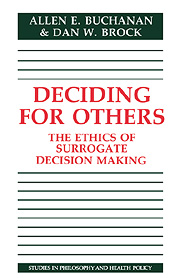Appendix one - Living trust and nomination of conservatorship
Published online by Cambridge University Press: 05 June 2012
Summary
There are two other important, legally recognized instruments, by which a person, when competent, may exert control over decisions that are made after he or she becomes incompetent: a living trust and nomination of conservator. Although neither of these devices provides comprehensive control over future decisions, each is useful for limited purposes for some individuals.
LIVING (INTERVIVOS) TRUST
A Trust is a disarmingly simply concept. Once viewed as a preserve of the wealthy, millions of middle-income and older Americans in general are now taking advantage of its benefits.
A valid Trust is created by a written agreement in which a person, the “settlor,” places some assets in the Trust for the benefit of him or herself or any other person. This latter person is called the “beneficiary.” Someone must also be appointed as “trustee” to manage and control the assets.
Perhaps most typical is the Intervivos or Living Trust. Such a Trust is expressly revocable, which means that the settlor can modify or revoke the terms of the agreement so long as that person retains legal capacity. Thus the settlor retains control even after the Trust is created, so long as he or she is competent.
The settlor (or settlors – often husband or wife) may create a Trust for one or more reasons. The first, and probably most common, is to avoid probate. The probate process, by which a decedent's assets are passed along to heirs, is expensive and typically very time-consuming.
- Type
- Chapter
- Information
- Deciding for OthersThe Ethics of Surrogate Decision Making, pp. 370 - 373Publisher: Cambridge University PressPrint publication year: 1990



